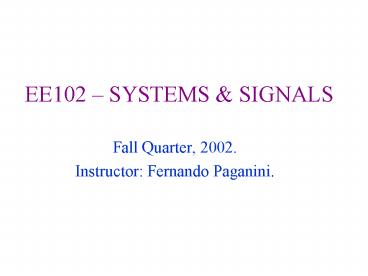EE102 SYSTEMS - PowerPoint PPT Presentation
1 / 18
Title:
EE102 SYSTEMS
Description:
Fall Quarter, 2002. Instructor: Fernando Paganini. Lecture 1. Intro to Signals & Systems ... Signal: Function that describes the evolution of a variable ... – PowerPoint PPT presentation
Number of Views:49
Avg rating:3.0/5.0
Title: EE102 SYSTEMS
1
EE102 SYSTEMS SIGNALS
- Fall Quarter, 2002.
- Instructor Fernando Paganini.
2
Lecture 1. Intro to Signals Systems
Signal Function that describes the evolution of
a variable with time.
- Examples
- Voltage across an electrical component.
- Position of a moving object.
3
Sound pressure of the air outside your ear
p
t
- Information lies in the time evolution.
- The signal can be converted to and from other
domains - electrical (in a stereo), electro-chemical (in
your brain). - What matters is the mathematical structure.
4
Signal examples (cont)
- Population of a species over time (decades)
- Daily value of the Nasdaq
Time can be continuous (a real number) or
discrete (an integer). This course focuses on
continuous time.
5
System component that establishes a relationship
between signals
- Example circuit
- Relationship between voltages and currents.
6
Systems examples
- Car Relationship between signals
- Throttle/brake position
- Motor speed
- Fuel concentration in chamber
- Vehicle speed.
- Ecosystem relates populations,
- The economy relates GDP, inflation, interest
rates, stock prices, - The universe
7
Math needed to study signals systems?
Example 1 static system
Vo
R1
I
Vs
R2
- Not much math there
- Time does not enter in a fundamental way.
8
Example 2 dynamical system
Vo
R
Vs
C
I
- Switch closes at t0. For t gt 0, we have the
ordinary - differential equation (ODE)
Solution
Time is essential here.
9
Dynamic, differential equation models appear in
many systems
- Mechanical system, e.g. the mass-spring system
- Chemical reactions
- Population dynamics
- Economic models
10
The issue of complexity
- Consider modeling the dynamic behavior of
- An IC with millions of transistors
- A biological organism
- Reductionist method zoom in a component, write
for it a differential equation model, then
combine these into an overall model. - Difficulty solving those ODEs is impossible
even numerical simulation is prohibitive. - Even harder design the differential equation
(e.g., the circuit) so that it has a desired
solution.
11
The black box concept
x
y
- Idea describe a portion of a system by a
input-output (cause-effect) relationship. - Derive a mathematical model of this
relationship. This can involve ODEs, or other
methods we will study. Make reasonable
approximations. - Interconnect these boxes to describe a more
complex system.
12
Definition Input-Output System
y
x
- The input function x(t) belongs to a space X, and
can be freely manipulated from outside. - The output function y(t) varies in a space Y, and
is uniquely determined by the input function. - The relationship between input and output is
described by a transformation T between X and Y.
Notation
13
Example RC circuit as an input-output system
R
x(t)
y(t)
C
_
_
- We assume here that time starts at t0, y(0) 0
- To represent the mapping from x to y explicitly,
we - must solve the differential equation
Here
14
- This is a linear ODE, with constant
coefficients, and - non-homogeneous (nonzero right hand side).
- Let us review first how to solve the homogeneous
- equation
Solution by separation of variables
15
(No Transcript)
16
(No Transcript)
17
(No Transcript)
18
Recap RC circuit example































